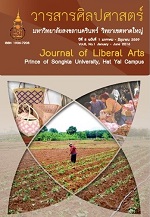Fostering student interaction in an ESP online class through scaffolding
Keywords:
Facebook, scaffolding, interaction, ESP, online learningAbstract
The notion of scaffolding is inspired by the theory of Social Constructivism which enables learners to co-construct new knowledge through interaction with the help of their teachers. The objective of the article is to unfold the teachers’ and students’ roles in promoting an interaction in an ESP class conducted on Facebook using a scaffolding technique. The participants of this study, whose English language proficiency was beginner level, were 118 second year higher vocational certificate students studying at a private vocational college in Hat Yai district, Songkla province in Thailand. The results of the study were obtained from analysis of 1,810 threads of interaction occurring over twelve weeks of instruction. It was discovered that the number of student interactions between students was higher than that with the teacher. The results also revealed that the teacher played an important role at the beginning of the course, helping the students to become accustomed to the online learning process, encouraging them to express ideas, and explaining the lessons. Eventually, the students took a more active role in the learning process while the teacher took an observer role. Despite the high frequency of online interactions, it was found that the students’ comments were limited to short answers. A new finding in this research is that the principles of flow and continuity played a major role in the scaffolding process, helping to foster interaction among beginners in English. Future research could investigate whether a blended-learning environment would help increase the quality of interaction using a counter-balanced research design.
Downloads
Published
How to Cite
Issue
Section
License
Copyright (c) 2016 วารสารศิลปศาสตร์ มหาวิทยาลัยสงขลานครินทร์ วิทยาเขตหาดใหญ่ (Journal of Liberal Arts Prince of Songkla University Hat Yai)

This work is licensed under a Creative Commons Attribution-NonCommercial-NoDerivatives 4.0 International License.
The authors retain the copyright to their article but the Journal of Liberal Arts, Prince of Songkla University reserves the exclusive rights to first publication.






